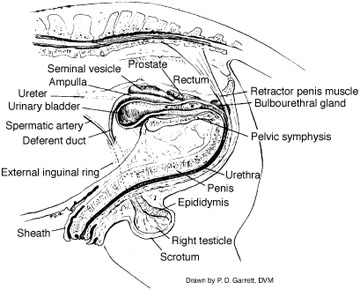External Reproductive Organs
Penis and Prepuce
The stallion’s penis consists of 3 parts: (1) the root or bulb, (2) the body or shaft, (the main part), and (3) the glans, the enlarged free end of the penis. When not erect, the penis is 50 cm long and 2.5 to 6 cm in diameter with the distal end 15 to 20 cm free in the prepuce. When erect, the penis doubles in length and thickness and the glans increases by 3 to 4 times. The prepuce or sheath is a double invagination of the skin that covers the distal portion of the penis when not erect. Examination of the penis and prepuce is most conveniently done at the time of washing. Allow the stallion to approach the mare in order to be stimulated to let down, at which time the penis extends from the sheath. Exercise caution because some stallions may be reluctant to be examined and cow kick or kick backwards at the examiner. Be careful to protect everyone involved. Examine the penis and prepuce both manually and visually. Grasp the shaft of the penis just behind the glans. Examine the urethral process for lesions and the associated structures for debris or other foreign material. The examination continues up the shaft where any injuries, scars or other lesions are noted. With the penis exposed, examine the internal and external portion of the prepuce. Usually a small amount of greasy smegma is found at the base of the penis. Any trauma or injury to the penis or prepuce can be very detrimental to the stallion’s ability to cover a mare and could result in long term psychological problems. This is particularly true if the stallion is kicked by the mare while attempting to breed her. Trauma can also occur by improper handling of artificial vaginas.
Scrotum
The scrotum is an outpouching of skin in the inguinal area that encloses the testes. It has a longitudinal midline where the two sacs are fused. The scrotum may be examined at the time of washing or after ejaculation, which may be safer for everyone involved. The stallion’s scrotum is not as pendulous as a bull’s and is held closer to the abdomen. The scrotum’s skin is soft and pliable with a greasy texture due to sebaceous glands. The scrotum is important in thermoregulation of the testicles.
Testicles and Epididymides
The testes are ovoid structures, measuring 8 to 12 cm long by 6 to 7 cm high by 5 cm wide. They consist of seminiferous tubules in which spermatogenesis occurs and interstitial tissues of which the Leydig cells produce testosterone. The testicles should be freely movable within the scrotal sac. The epididymides are divided into 3 parts: (1) head; (2) body and (3) tail. The head of the epididymis is closely attached to the testicle’s anterior dorsal aspect. The body of the epididymis continues along the testicle’s back side until it terminates at the rather large tail of the epididymis that is loosely attached to the testicle’s tail. The testes and epididymides are palpated through the scrotal wall to determine their presence, size, symmetry and consistency. The normal stallion has two testes. Palpation should reveal that they have the same consistency with no abnormalities of shape or texture. The right testis is normally slightly smaller than the left. Determine testicular size by measuring scrotal width of both testicles. Measure scrotal width using calipers at the point of greatest width with a nonerect penis. Scrotal width is positively correlated with daily sperm production and output. Normal scrotal widths range from 9 to 13 cm. Stallions older than 7 years of age tend to have greater scrotal widths than younger stallions. Certain medications, particularly androgens, adversely affect testicular size. Cryptorchidism is common in stallions and its genetic control is not fully understood. The left testicle is the one most commonly retained. Congenital cryptorchid stallions should not be considered for breeding.
Internal Reproductive Organs
The ductus deferens is the continuation of the epididymis and runs from the tail of the epididymis through the inguinal canal to the area of the neck of the bladder. The duct expands near the bladder to form the ampulla which acts as a sperm storage organ.
Accessory Sex Glands
The vesicular glands, prostate gland and bulbourethral glands are collectively called the accessory sex glands. They all provide a portion of the seminal fluid, but are not necessary for fertility. These glands are normally rectally palpated. The vesicular glands are usually the most difficult to palpate because before teasing they are essentially collapsed. However, after vigorous teasing, the vesicles enlarge due to the accumulation of the gels fraction and are easier to palpate. This is why it may be more desirable to palpate after teasing, but on the other hand, most stallions are more tractable following ejaculation. So, timing the rectal examination is mainly at the examiner’s discretion.
Learn More
- Understanding Horse Reproduction
- Stallion Reproduction
- Stallion Pre-Purchase Evaluation



